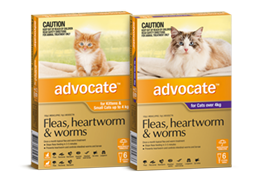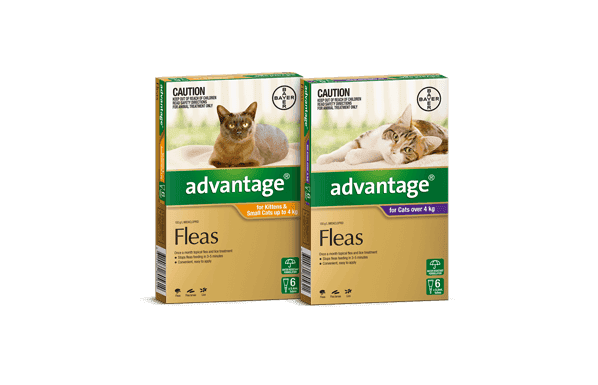Reviewed by Dr Sylvia Shortreed BVSc
Cats can pick up fleas surprisingly easily, and these parasites can quickly spread around your home unless you act quickly to prevent an infestation.
Fleas are one of the most common parasites affecting cats, and outdoor cats will likely come into contact with fleas regularly. Yet even indoor cats can get fleas if the parasites hitch a ride into your home: on you, another pet, or an uninvited guest like a rodent.
If you maintain a regular treatment schedule for your pet you will hopefully never have to deal with an infestation, but it’s still important to know what you’re up against.
The basics about fleas
Fleas are tiny, wingless insects that live on your cat’s body, feeding on their blood and laying eggs in your cat’s fur, which then drop off throughout your home. A single flea can lay up to 2000 eggs in its lifetime, and its full life cycle – from egg to larva to pupa to adult – can take place in a few weeks. Although they don’t live in human hair, fleas do bite humans – especially on the ankles and lower legs – and they will also jump onto and infest other pets in the household.
How to spot fleas on your cats
It can be quite hard to spot fleas on cats, and the first symptom you may notice is scratching. You can check your cat regularly by gently combing with a flea comb and shaking the fur onto a damp piece of white tissue. If dark specks (‘flea dirt’) appear and turn reddish brown, this indicates that your cat has fleas. In many cases it may not be obvious that your pet has fleas though, as fleas burrow deep into your pet’s fur and move away quickly when the fur is parted, making them hard to find.
Why flea bites can be dangerous for cats
Flea bites are painful and itchy for your cat, and they can cause a range of additional problems, including:
Flea allergy dermatitis (FAD): FAD is an allergy to flea saliva that can set off a severe reaction and intense itching from just a few flea bites. If your cat has FAD, their skin may look sore and crusty. They can also lose fur from over-grooming, resulting in bald patches often on their belly, back legs and tail area. In severe cases, this constant scratching and grooming can create open wounds, making your cat susceptible to secondary skin infections.
Anaemia: Kittens and elderly cats can become anaemic from blood loss if bitten too many times. This type of anaemia is a direct result of fleas feeding on the cat's blood. Cats suffering from anaemia may display symptoms such as lethargy, weakness, pale gums, and rapid breathing, and may require prompt medical attention.
Tapeworm: If your cat swallows fleas infected with tapeworm larvae while grooming, your cat can end up with a tapeworm infection. Tapeworms can lead to weight loss, vomiting, and a change in appetite. Additionally, tapeworms can sometimes be seen as small, rice-like segments in your cat's faeces or around their anus, and even where they like to sleep.
Skin infections: Persistent scratching and biting due to flea bites can lead to open sores and wounds on the skin, which may become infected and require antibiotic treatment.
Behavioural changes: Chronic flea infestations can also lead to behavioural changes in your cat, such as restlessness, irritability, and changes in eating and sleeping habits.
How to get rid of fleas on your cat
The first step in dealing with a flea infestation is to use an effective flea-preventative treatment for cats. It might feel a bit overwhelming with so many options available – spot-on treatments, tablets, collars, sprays – but don't worry, we're here to help you make the right choice for your feline friend.
Spot-on treatments such as Advocate™ and Advantage™ are popular and effective choices. These treatments are applied to the back of your cat’s neck, spreading throughout the skin and kill fleas on contact. The added benefit of these treatments is that they do not require the flea to first bite your cat to be killed, which can be a huge relief, particularly for cats with Flea Allergic Dermatitis (FAD). Also, many of these treatments work against other parasites, providing a more-in-one solution.
Oral tablets are another type of flea treatment that can work wonders. They're given just like a regular pill and work by entering your cat's bloodstream. When a flea bites your cat, it ingests the medicine and dies. Some tablets start working within hours, eliminating fleas present on your cat and offering rapid relief.
Flea collars, like Seresto™, offer a convenient alternative to spot-on treatments and pills. The Seresto collar for cats provides the longest lasting protection compared to any other treatment on the market. These collars release a pesticide that kills fleas on contact, meaning the flea does not have to bite your cat for the treatment to work. They provide up to 8 months of continuous protection against fleas and the tapeworm larvae they can carry, as well as ticks.
Flea sprays are another tool in your arsenal. They can be used directly on your cat and around your home, especially in places where your cat likes to hang out. They kill fleas on contact and can also kill flea larvae, helping to control an infestation more rapidly.
Always read and follow product guidelines for appropriate application and use.
Fleas on cats: do they pose a health risk for humans?
While it's crucial to understand the health complications that fleas can inflict on our feline friends, it's equally important to be aware of the risks these pesky parasites might pose to us humans. After all, we share our homes and often our couches with our beloved cats, don't we?
Fleas are not just a nuisance due to their bites, which can cause itchy, red welts; they can also potentially transmit diseases to humans. Here are a few health risks associated with fleas:
Flea Allergy Dermatitis (FAD): Much like our cats, some of us humans can also develop an allergy to flea saliva, leading to intense itching and inflammation at the site of the flea bite. This allergic reaction can result in hives or a rash that can be quite uncomfortable.
Zoonotic diseases (diseases transmitted to humans from animals)
Cat Scratch Disease (Bartonellosis): Cat fleas can carry and transmit the bacteria Bartonella henselae, which causes Cat Scratch Disease. This condition is typically transmitted to humans when flea dirt from an infected flea makes contact with a wound or scratch, often through a cat's scratch. Symptoms can include fever, headaches, swollen lymph nodes, and fatigue. While usually not severe, in rare cases, it can lead to serious complications, especially in people with weakened immune systems.
Tapeworms: If a human accidentally ingests a flea (which is more likely to occur in children), it can result in a tapeworm infection. Tapeworms are intestinal parasites and can cause symptoms like abdominal discomfort, diarrhea, and weight loss.
Typhus: Though very rare, fleas can carry and transmit the bacteria that cause typhus. Symptoms can include fever, headaches, and a rash, and in severe cases, it can lead to complications like pneumonia and meningitis.
Although these health complications are concerning, and it’s important to be aware of them, with good flea control of both your cat and their environment, the risk of contracting any of these diseases is rare.
Addressing a flea infestation in your home
While treating your cat is the first step, it's equally important to address the flea infestation in your home. After all, the majority of a flea's life cycle is spent off your pet. By following these steps, you can make your home an extremely inhospitable environment for fleas:
1. Clean, clean, clean: Begin by giving your home a thorough cleaning. Vacuum carpets, rugs, upholstery, and even the nooks and crannies where your cat likes to sneak in a nap. Vacuuming helps to remove fleas at all life stages – from eggs to larvae to adults. Don't forget to empty the vacuum bag or canister outside to ensure any caught fleas don't escape back into your home! A nifty helping hand to vacuuming away flea larvae, pupae and eggs in the house is to use a flea product containing imidacloprid on your cat (Seresto™ collar, Advocate™, and Advantage™) that kills flea larvae in the environment.
Always read and follow product labels.
2. Hot Water Wash: Fleas and their eggs can't survive high temperatures. So, gather up your pet's bedding, soft toys, your bedding (if your cat sleeps with you), and even your clothes, and wash them in the hottest water setting recommended for those fabrics. Follow up with a high-heat drying cycle for an extra punch.
3. Use a Household Flea Spray: There are many vet-approved household flea sprays available on the market. These sprays contain insecticides that kill adult fleas, as well as insect growth regulators (IGRs) that prevent flea eggs and larvae from developing. Spray your carpets, furniture, pet bedding, window sills, and anywhere else your pet frequents. Remember to follow the safety instructions on the product label.
4. Flea Bombs or Foggers: If the infestation is large and unmanageable with regular sprays, you might consider using a flea bomb or fogger. These products release a cloud of insecticide that penetrates carpets, cracks, and other hiding spots where sprays might not reach. However, they require you and your pets to leave your home for several hours and then thoroughly ventilate it upon return. Always follow the product instructions.
5. Regular Check-ups: Even after you've dealt with an infestation, stay on the lookout for signs of fleas. Regularly check your pet and their favourite spots for any signs of these pests making a comeback.
6. Professional Pest Control: If the situation feels out of control despite your best efforts, it might be time to call in the professionals. Pest control companies have access to treatments that may be more effective than those available over the counter.
As we have seen, understanding the world of cats and fleas is important for any cat owner. These tiny pests can cause an array of health problems for both feline friends and humans alike. However, with the right knowledge and tools, you can safeguard your household from these unwelcome invaders. Staying vigilant, maintaining regular preventative measures, and acting promptly at the first sign of fleas can help ensure a comfortable, healthy life for your cat and a harmonious living environment for everyone in your household.
Resources
1. Mehlhorn et al. Parasitol Res (2001) 87: 198-208

Seresto collar for cats & dogs
Seresto provides long-lasting flea protection for cats and dogs for 8 months, and tick protection for dogs for 4 months





